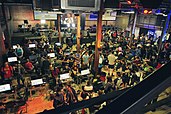Wikipedia:Main Page history/2020 November 6b
From today's featured articleThe 1981 UEFA Cup Final was an association football match played over two legs between AZ '67 of the Netherlands and Ipswich Town of England. It was the final of the 1980–81 season of European cup competition, the UEFA Cup. Both Ipswich and AZ '67 were appearing in their first European cup final. Watched by a crowd of 27,532 on 6 May at Ipswich's home ground, Portman Road (pictured), Ipswich won the first leg 3–0; John Wark, Frans Thijssen and Paul Mariner scored. In the second leg at the Olympic Stadium in Amsterdam on 20 May, a crowd of 28,500 watched Ipswich take an early lead courtesy of a Thijssen goal. AZ '67 quickly equalised through Kurt Welzl before taking the lead after a goal from Johnny Metgod. Wark scored again for Ipswich to equalise the leg, but AZ '67 struck back through Pier Tol and Jos Jonker. Ipswich won the final 5–4 on aggregate to win their first and, as of 2020, only European trophy. (Full article...) Did you know ... Neelofa and Nabil on MeleTOP
|
In the news
On this dayNovember 6: Gustavus Adolphus Day in Estonia, Finland and Sweden (1632); Finnish Swedish Heritage Day in Finland
More anniversaries:
|
From today's featured list
Numerous tournaments have been held for the crossover fighting video game Super Smash Bros. for Wii U. Players control one of 58 characters drawn from Nintendo and third-party game franchises, and try to knock their opponents out of an arena. Each player has a percentage meter which rises as they take damage; characters become easier to knock into the air or out of bounds as the percentage increases. While Smash for Wii U tournament rules initially varied, by 2016 they had standardized; the first player to knock their opponent out of the arena twice within a six-minute match timer wins the set. Matches are played as best-of-three sets in early rounds of the tournament and best-of-five sets in later rounds. Tournaments use the double-elimination format. Smash Bros. tournaments are generally seeded so that the best players do not face off against each other until the later stages of an event. (Full list...)
Today's featured picture

|
An iceberg is a large piece of freshwater ice that has broken off a glacier or an ice shelf and is floating freely in the open sea. Because the sea around this iceberg is so calm, the underwater portion is visible through the clear water. The largest iceberg ever detected was B-15, which split from the Ross Ice Shelf in Antarctica in 2000, and had a flat top; it had a surface area of 11,000 km2 (4,200 sq mi) and broke into several pieces in 2002 and 2003. This picture depicts an irregularly shaped iceberg with a rounded top, calved from a glacier in the Arctic and photographed in the Arctic Ocean north of Svalbard. Photograph credit: Andreas Weith
Recently featured:
|
Other areas of Wikipedia
- Community portal – Bulletin board, projects, resources and activities covering a wide range of Wikipedia areas.
- Help desk – Ask questions about using Wikipedia.
- Local embassy – For Wikipedia-related communication in languages other than English.
- Reference desk – Serving as virtual librarians, Wikipedia volunteers tackle your questions on a wide range of subjects.
- Site news – Announcements, updates, articles and press releases on Wikipedia and the Wikimedia Foundation.
- Village pump – For discussions about Wikipedia itself, including areas for technical issues and policies.
Wikipedia's sister projects
Wikipedia is hosted by the Wikimedia Foundation, a non-profit organization that also hosts a range of other projects:
Free media repository
Wiki software development
Wikimedia project coordination
Free textbooks and manuals
Free knowledge base
Free-content news
Collection of quotations
Free-content library
Directory of species
Free learning resources
Free travel guide
Dictionary and thesaurus




